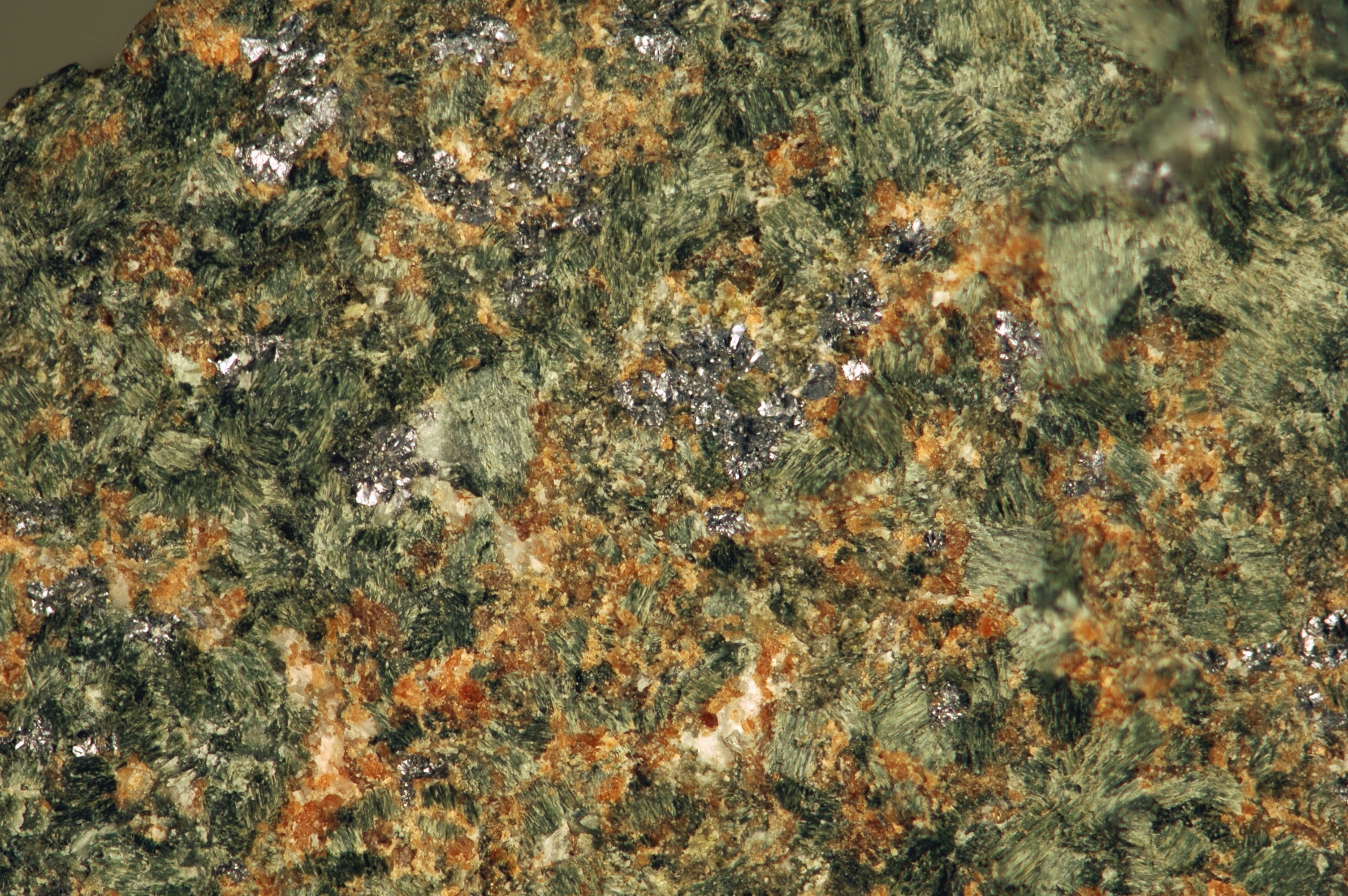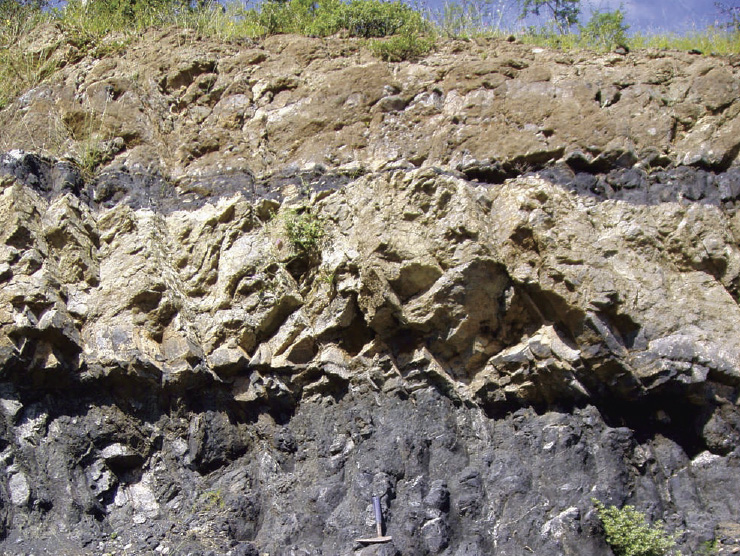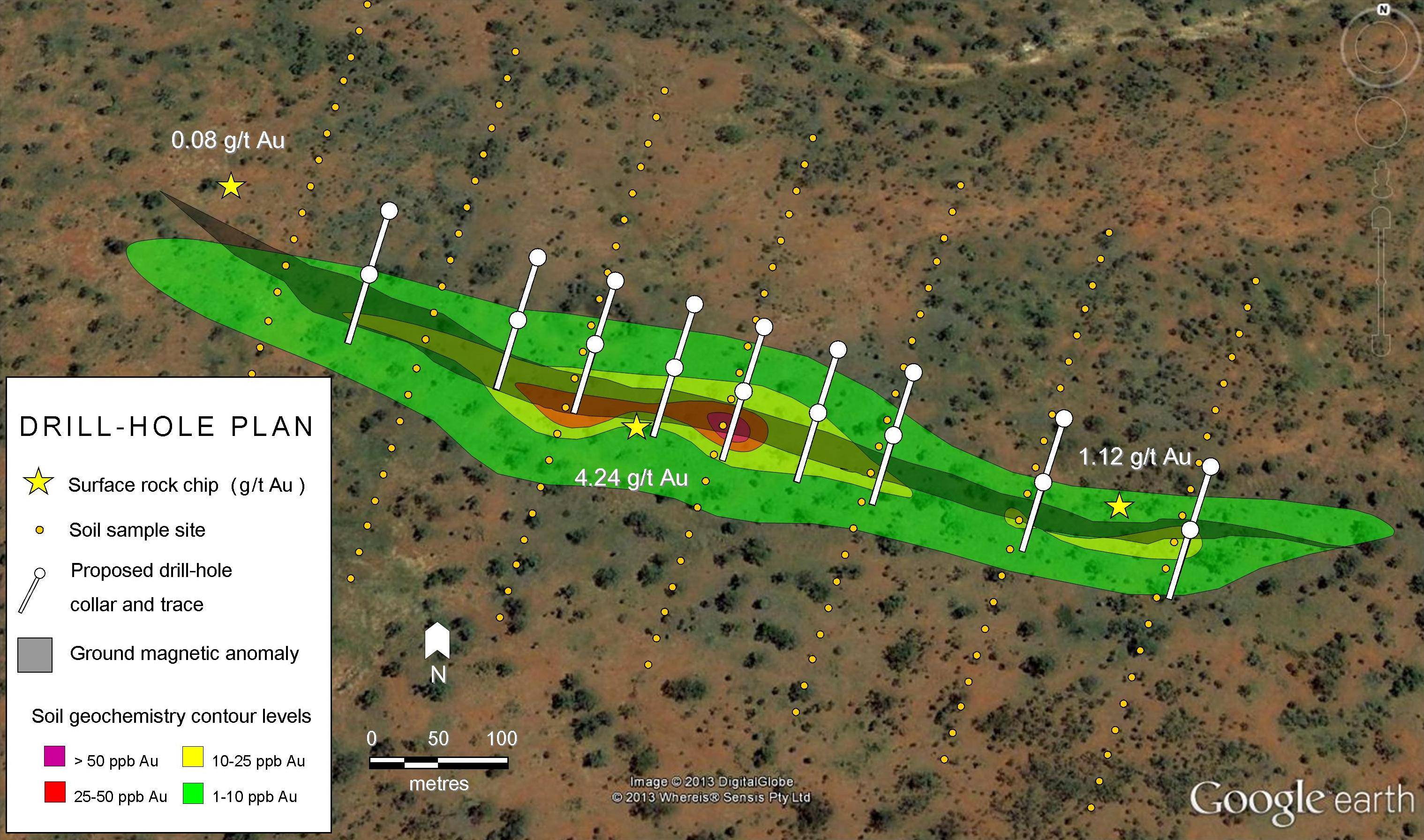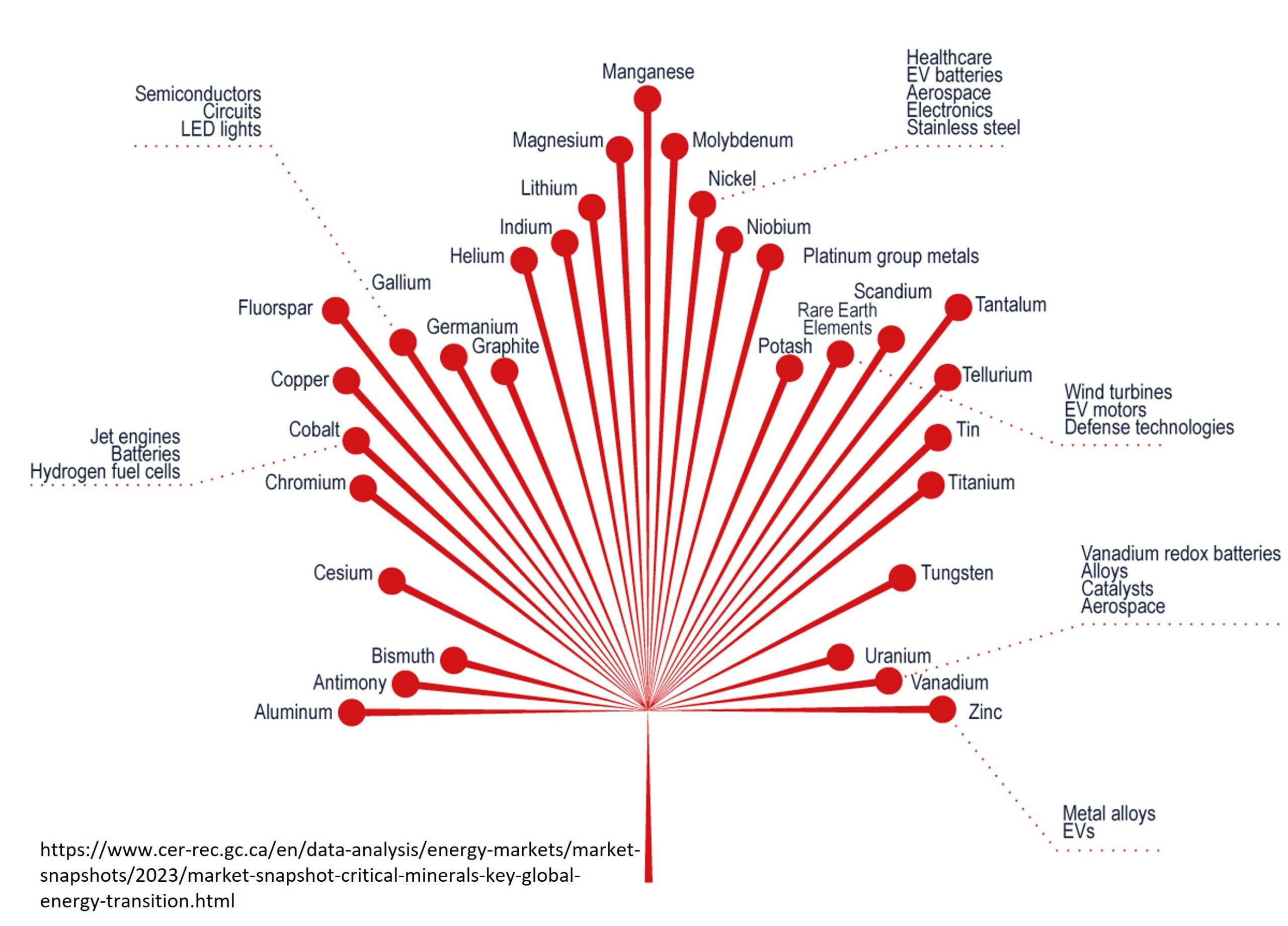At Misery Lake, they have a very large and conveniently bullseye shaped REE target to explore while they figure out how to move forward at Strange Lake.
[box type=”info” align=”aligncenter” ]Disclaimer: This is an editorial review of a public mining company press release and is not an endorsement. It may include opinions or points of view that may not be shared by the companies mentioned in the release. The editorial comments are highlighted so as to be easily separated from the release text and portions of the release not affecting this review may be deleted. Read more at How to Use this Site.[/box]
TORONTO, ONTARIO–(Marketwired – July 24, 2014) – Quest Rare Minerals Ltd. (TSX:QRM)(NYSE MKT:QRM) is pleased to announce the drill results from the 2014 winter drill program at its Misery Lake Project. The Misery Lake Property consists of a single claim block comprising 170 claims covering an area of 8,334 hectares. The property is located 120 km south of Quest’s Strange Lake rare earth development project. The drill holes have intersected strong REE mineralization containing significant concentrations of the element scandium from a new area of mineralization, called the “Boulder Zone” at the northeastern corner of the property.
[box type=”note” align=”aligncenter” ]The last time we reported on Quest minerals was in October,2013 when they released a pre-feasibility study on their Strange Lake property. In January the company promoted Dr. Dirk Naumann to executive Vice-President to oversee and direct improvements to its pre-feasibility study. In April 2014, the company filed an updated pre-feasibility study for the Strange Lake deposit and reduced the capital costs by $1.23 billion. The unfortunately named Misery Lake property is the company’s second REE (Rare Earth Element) prospect located 120 km south east of the Strange Lake property.
The “Boulder Zone” has been an area of interest within the Misery Lake property due to the REE mineralization containing concentrations of Scandium. Scandium is a rare earth element that has many useful industrial applications. Scandium is used for solid oxide fuel cells, electronics, high-intensity discharge (HID) lighting and lasers used for research. The element is also useful in creating strong alloys, especially in the aviation industry due to its high strength-to-weight ratio. According to the USGS (United States Geological Survey) the price of Scandium oxide was trading at $3700/kg at 99.99% purity in 2012. [/box]
The Misery Lake drill program commenced on March 30, 2014 and was completed on April 20, 2014. A total of 7 holes were drilled for 1,437 meters. A new mineralized zone, the “Boulder Zone”, was traced back to its bedrock source from a previously-identified 7-km long, 065°-trending rare earth element (REE) mineralized boulder field. The zone was intersected in three drillholes (ML14026, ML14028 and ML14029) over an east-west strike length of 200 m and vertically to 200 m. Quest has yet to confirm the dip of the new zone but early indications are that it is sub-vertical to steeply south-dipping and open along strike in both directions and at depth. Mineralized core intersections of between 27.6 m and 199.69 m were returned from the drilling. Best assays returned 1.48% total rare earth oxides plus yttrium (TREO+Y(1)) over 62.8 m (drillhole ML14026) including 1.72% TREO+Y(1) over 27.6 m. The drilling results also returned important levels of scandium oxide (Sc2O3) between 0.0235% to 0.0351% (235 to 351 grams/tonne Sc2O3) over the drilled intervals. Highlights of the results, which are interpreted to be apparent thickness, are shown in Table 1 and the location of the drillholes is presented in Table 2 in NAD 83, Zone 20N projection.
| Table 1: Winter Diamond Drill Results, Misery Lake Project, Québec | ||||||||
| Hole ID | From m |
To m |
Thickness m |
TREO+ Y(1)% |
LREO(2)% | HREO +Y(3)% |
HREO+Y/ TREO+Y |
Sc2O3 % |
| ML14026 | 14.77 | 182.60 | 167.83 | 1.1760 | 1.0013 | 0.1747 | 14.86 | 0.0262 |
| ML14026 | 14.77 | 42.40 | 27.63 | 1.7206 | 1.4686 | 0.2521 | 14.65 | 0.0351 |
| ML14026 | 14.77 | 77.55 | 62.78 | 1.4779 | 1.2607 | 0.2172 | 14.70 | 0.0304 |
| ML14028 | 13.22 | 212.91 | 199.69 | 1.0800 | 0.9178 | 0.1621 | 15.01 | 0.0235 |
| ML14028 | 13.22 | 91.14 | 77.92 | 1.4065 | 1.1977 | 0.2088 | 14.85 | 0.0280 |
| ML14029 | 13.35 | 93.40 | 80.05 | 1.3353 | 1.1362 | 0.1991 | 14.91 | 0.0286 |
| ML14030 | 177.00 | 183.04 | 6.04 | 1.1442 | 0.9632 | 0.1810 | 15.82 | 0.0319 |
| (1) – Total Rare Earth Oxides (TREO+Y) include: La2O3, CeO2, Pr6O11, Nd2O3, Sm2O3, Eu2O3, Gd2O3, Tb4O7, Dy2O3, Ho2O3, Er2O3, Tm2O3, Yb2O3, Lu2O3 and Y2O3. |
| (2) – Heavy Rare Earth Oxides (HREO+Y) include: Eu2O3, Gd2O3, Tb4O7, Dy2O3, Ho2O3, Er2O3, Tm2O3, Yb2O3, Lu2O3 and Y2O3. |
| (3) – Light Rare Earth Oxides (LREO) include: La2O3, CeO2, Pr6O11, Nd2O3 and Sm2O3. |
[box type=”note” align=”aligncenter” ]The company has stated that the orientation of the mineralization is sub-vertical to vertical. Here the drilling was completed vertically (The dip is -90) along the orientation of the mineralization. Based on this information its hard to say if the orebody is narrow but what we do know is that these results represent the apparent thickness. Some new holes drilled at an orientation of -45 degrees or shallower might effectively intersect the orebody and help determine its true thickness. [/box]
Misery Lake Geology & Geophysics
The Misery Lake property is dominated by a six-km diameter, circular intrusion comprising of multiple concentric rings of varying types of syenite and other minor units such as syenitic pegmatite. This intrusive complex exhibits gradational contacts with the host Mistastin Batholith, which comprises predominantly rapakivi granite in the Misery Lake area.
[box type=”note” align=”aligncenter” ]The prospect is located within a large igenous intrusion and at the surface it looks like a dartboard. As the hot magma rose to the surface, complex chemical reactions occurred forming different types of rocks that gradually formed as concentric layers from the center to the outer edges. We’ve included a geological map of the property below.
The company has been using aeromagnetic surveys for geophysical exploration however another tool that is commonly used for the exploration of rare earth elements are radiometric surveys. Syenite is potassium rich rock and contains the radioactive isotope Potassium-40 which releases gamma rays that can be detected and measured by geophysical instruments. [/box]
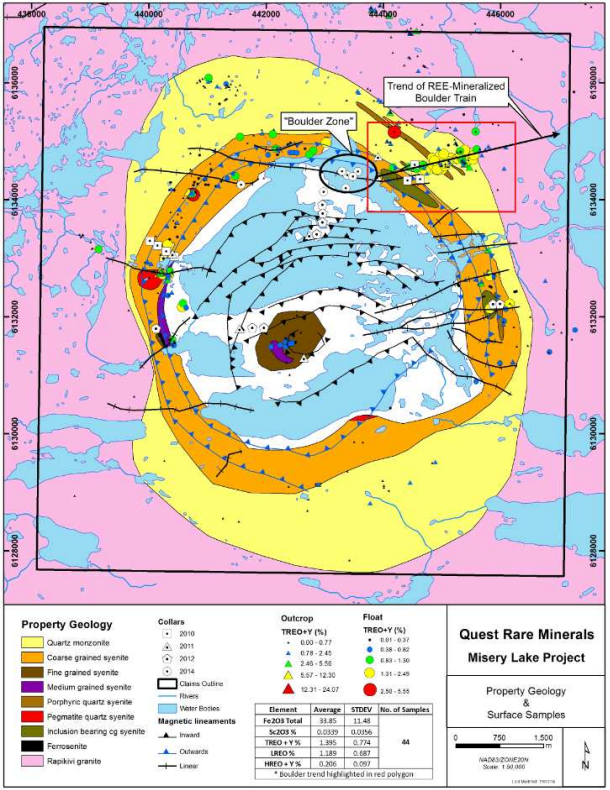
Quest completed a high-resolution ground magnetic survey at Misery Lake in the winter of 2013, which allowed continuous data collection over the entire property. This ground magnetics survey revealed that the circular magnetic features in both the outer and inner rings are in fact each multiple rings rather than a singular rings, suggesting repetitive stages of differentiation and magmatic intrusion. This survey provided increased resolution to earlier airborne data collected from the property that allowed the identification of multiple east-west oriented, cross-cutting magnetic features that were previously unknown. Most importantly, as described below, a possible source for the REE-mineralized boulders was identified.
[box type=”note” align=”aligncenter” ]A boulder train is a line or series or small rocks or large boulders that are removed and transported away from the local bedrock by glaciers. By following ice flow direction geologists can trace back the origin of the boulders. Quest had identified a series of boulders that followed a peculiar east-west trend, parallel to a cross-cutting east-west magnetic trend. The company suggested that this magnetic feature maybe the source of the boulders. By utilizing a ground based magnetic survey the company was able to refine their current aeromagnetic maps to identify these structures as drill targets. [/box]
2014 Exploration Drilling Program
In late March 2014, Quest mobilized a crew to its Misery Lake camp to prepare for a winter drilling program. The purpose of this drilling campaign was to define possible sources of an REE-mineralized boulder train. One of the key findings from prospecting and mapping over the course of Quest’s surface exploration programs has been the identification of a prominent REE-mineralized ferrosyenite boulder train. This boulder train, which has been extensively sampled over a distance of 7 km (Figure 3) comprises predominantly angular to sub-rounded, small (<10 cm) to large (>2 m) moderate-to-strongly magnetic ferrosyenite. Quest used the known ice direction and the very discrete nature of this boulder trend parallel to the glacial direction to postulate that an unusual east-west trending and cross-cutting magnetic feature may be the source of the ferrosyenite boulders and planned several holes in the 2014 drilling program to test this hypothesis. The magnetic feature is directly down ice of the boulder field.
Drilling successfully intersected well-mineralized ferrosyenite and fayalite syenite while drill testing the cross-cutting magnetic feature described above. By comparing the TREO+Y, iron oxide (Fe2O3), Sc2O3 (Table 3) and other metal grades from the boulders*, against the upper 10 meters** of core from ML14026, ML14028 and ML14029, it is clear that they are very similar. The textures of the boulders and core are very similar, with drillcore commonly presenting higher values than the boulders.
[box type=”note” align=”aligncenter” ]Diamond drilling intersected mineralization within ferrosyenite and fayalite syenites. Ferro- and fayalite bearing syenites are rocks in rich in iron and potassium. By comparing the boulder train to the rocks intersected in drill core from its latest drilling program the company can attempt to correlate if they have found the source of the boulder train. [/box]
The implications of these results are significant because they allow Quest to employ a new exploration model for the discovery of additional REE+Y+Sc mineralized zones in future exploration programs on the property. ML14030, which was drilled to the west on a possible continuation of the previously-described magnetic feature, intersected strongly REE mineralized ferrosyenite at depth over a narrower thickness. This suggests to Quest that east-west magnetic features may represent a significant and untested target type at Misery Lake (Figure 5).
| Table 3 – Comparison Chart Showing Boulder and Drill Sampling Results, Boulder Zone, Misery Lake Project, Québec | |||||||||||||
| Type | Boulders | ML14026 | % Diff | ML14028 | % Diff | ML14029 | % Diff | ||||||
| TREO+Y (%) | 1.395 | 1.667 | 19.50 | 1.465 | 5.02 | 1.527 | 9.46 | ||||||
| Fe2O3Total (%) | 33.85 | 37.99 | 12.23 | 35.39 | 4.55 | 39.57 | 16.89 | ||||||
| Sc2O3(%) | 0.0339 | 0.0344 | 1.69 | 0.0289 | 14.75 | 0.0316 | 6.73 | ||||||
*based on 44 boulders
**based on upper 10 m of core
[box type=”note” align=”aligncenter” ]Based on the table above, the company concluded that the drill core appears very similar to the boulder train. They didn’t specify the types of analysis used for the drill core nor the boulder train. So we can only assume that the same analysis and sample size was used to draw an accurate comparison. [/box]
Qualified Person
Mr. Pierre Guay, P.Geo., is the qualified person on the Misery Lake exploration project information presented in this press release under National Instrument 43-101 Standards of Disclosure for Mineral Projects and is responsible for the technical contents of this press release and has approved the disclosure of the technical information contained herein. The data verification was conducted by Patrick Collins P.Geo. under the supervision of Pierre Guay P.Geo. The data verification was conducted according to The Quest’s Guidelines, Protocols and Procedures Manuals.
[box type=”note” align=”aligncenter” ]
Considering that their first Strange Lake pre-feasibility study contained almost a billion dollars in discretionary padding, it’s good to see that they have crunched some numbers and come up with something that’s more well defined. The project was already incredibly expensive without extra padding. At Misery Lake, they have a very large and conveniently bullseye shaped REE target to explore while they figure out how to move forward at Strange Lake. It will be interesting to see what comes of it.
Quest is currently trading at $0.24 close to it’s 52-week low of $0.235. The companies stock has been on a steady decline since October 2013 when it was trading close to $0.89.
[/box]
[box type=”success” align=”aligncenter” ]Have a company or release you’d like us to look at? Let us know though our contact page, through Google+, Twitter or Facebook.[/box]

